 We’re human, we don’t always say the right things or have the best timing.
We’re human, we don’t always say the right things or have the best timing.
This is doubly true for people navigating the world of communications.
Every communications pro has seen our fair share of terrible media pitch examples.
The ones that make us cringe and feel embarrassed.
Likewise, if you’ve been in the business for any length of time, you know how it feels to have a pitch rejected, or worse, felt the wrath of a disgruntled journalist.
Even the most well-meaning communications pro can send an ill-timed or poorly thought through media pitch.
The fact that we are living in an uncertain, uncharted, and downright scary time right now makes it that much more difficult.
For those who are still signing on to work every morning and communicating online, it’s important to maintain decorum for how we’re communicating with the rest of the world.
To help you do that, here are five terrible media pitch examples to keep top-of-mind especially now—and all the time.
Use these as reminders to make sure you don’t make the same mistakes and produce the most successful pitches possible.
Using examples from Twitter, we can dissect the mistakes of other communications pros to better inform our own outreach practices.
Lazy Media Pitch Examples
While it isn’t uncommon to refer to a template when you are reaching out to multiple reporters, it’s imperative to check (and double-check) you’ve personalized your template as much as possible.
This means do NOT, ever, just copy, paste, and send.
You must actually do the work to ensure the journalist you’re contacting knows that email is meant for them and the pitch is relevant to their needs and perspective.
Source: https://twitter.com/bendee983/status/1240684414788665346
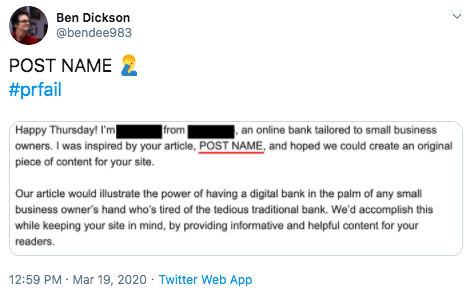
The moral of this story is: do not send mass template emails unless you’re willing to risk ending up blacklisted or shamed on Twitter.
Do the work.
Take the time to research and personalize.
Under-Researched Media Pitch Examples
For the most part, digital marketers understand that personalization is key to making any real connection online.
This is true with clients, social media connections, and email outreach alike.
If you’re a fan of a journalist’s writing, you may cite a recent article you’ve read.
Or if you’re friends on social platforms, a personal reference works as well.
However, it’s never a good idea to send a pitch without having done any research on the person you’re reaching out to.
Source: https://twitter.com/CaitlinKellyNYC/status/1240312459367518213
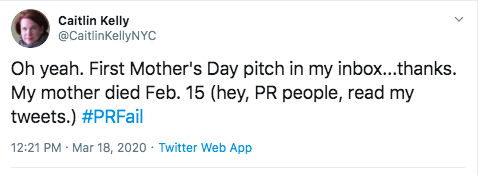
This is obviously an incredibly sad media pitch example of an email gone wrong.
But it does illustrate a couple of important things thing:
- Empathy matters.
- Journalists want well researched and relevant pitches.
While I doubt the message referenced in this Tweet was sent maliciously, it likely led to the end of a professional relationship.
Of course, people make mistakes.
But these kinds of situations are perfect examples of why research matters.
Take the time to craft pitches that speak to the reporter, as an individual.
The Generic Media Pitch
Are you seeing a trend here?
Personalization is key.
I cannot understate the importance of personalization.
Source: https://twitter.com/farhanmohamed/status/1111327384030986240
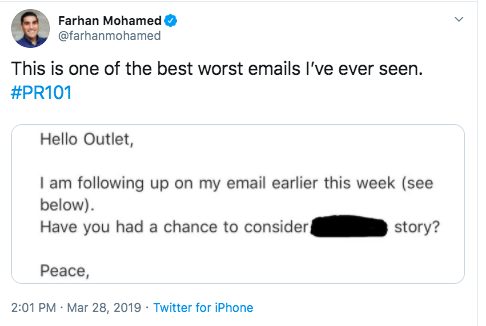
First of all, misspelling the name of a person or company is borderline unforgivable, but not even attempting to write one in the first place is even worse.
If you aren’t going to put in the effort, why should a journalist?
This is the minimum amount of personal information journalists and news outlets expect to see in a pitch.
It is essential.
So stop blindly pushing send on your email, just to check it off your list.
And start actually caring about the person on the other end.
Secondly, digital PR pros should be incorporating personalization into each step of their outreach strategy—this includes a follow-up.
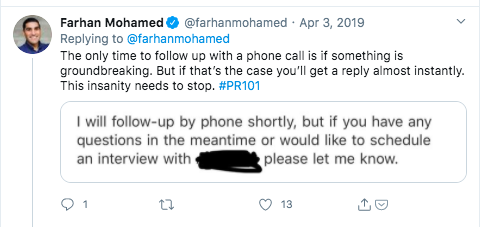
More than 25% of journalists don’t even want to see a follow-up email in their inbox, let alone a sub-par one.
Comment on their recent news coverage or even a current event; something to make the contact feel like more than just a means to an end.
This doesn’t mean every pitch should be a novel, but treating a media pitch like a transaction is not the way to make friends in this business (or be successful).
The Opportunistic Pitch
It’s nice when your content or service aligns with current events or social needs.
Selling dog leashes on National Adoption Weekend or serving up a political survey during election season is the kind of newsworthiness communications pros pray for.
However, it’s important to avoid extorting trending news for the sake of a pitch.
Source: https://twitter.com/bonniemoon/status/1239049974853353473
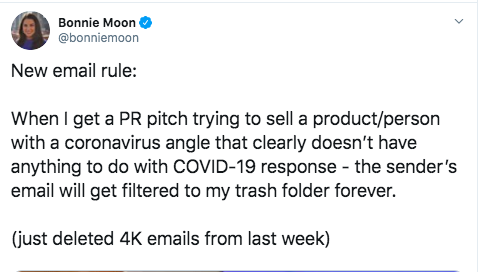
We’re living in crazy times right now.
News surrounding the COVID-19 virus has been plastered on the front page of every publication in the world and it’s unlikely that this coverage will let up anytime soon.
Providing information or data that can help the general public during this time is something writers appreciate right now.
But there is a tendency to connect completely unrelated pitches to the virus in an attempt to secure coverage.
This is a mistake.
Obviously, freeloading off of an international crisis for personal or professional gain is something journalists (and people in general) do not take kindly to.
It’s imperative that communication pros remember their ethical training and remain altruistic during times like these.
This doesn’t mean that information on national emergencies needs to be the only thing in the news during a crisis, but only link a product, service, or piece of content to a trending story if it is actually related and relevant.
The Hopeless Pitch
Everyone has bad days, and in the past few weeks in light of the Coronavirus, many people are on edge.
Source: https://twitter.com/jonmacelive/status/1238114332120100868
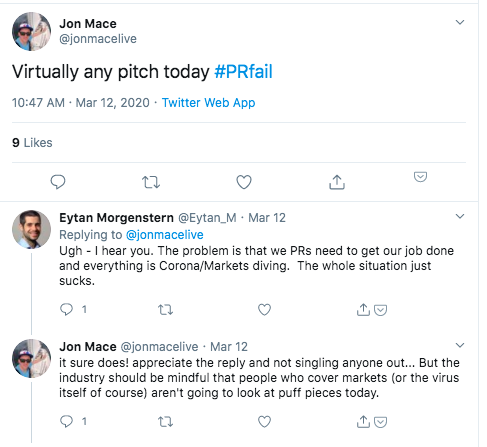
Context is crucial for pitches at this time.
While in the beginning, most pitches on topics non-COVID-19 were paused, we now need to adapt to our new norm and let context and common sense guide us when deciding when a non-COVID pitch is appropriate and when it is not.
This is new territory so some of it is learning as we go.
It might feel strange to send emails about your new workplace study or company news release during a pandemic, but writers on Twitter and HARO are starting to request story ideas that are unrelated to the virus.
So, use your own judgment to decide what’s appropriate and what’s a priority within your own team.
Pitchin’ Ain’t Easy
Remember, we’re all trying our best.
Even in light of the current international landscape, there are ways to remain tactful and helpful in your media outreach.
We’re learning how to keep moving forward in a time of uncertainty and the skills we’re acquiring now will make us better communicators in the long run.
Image by Sasin Tipchai from Pixabay